The Economics and Statistics Division maintains archives of previous publications for accountability purposes, but makes no updates to keep these documents current with the latest data revisions from Statistics Canada. As a result, information in older documents may not be accurate. Please exercise caution when referring to older documents. For the latest information and historical data, please contact the individual listed to the right.
<--- Return to Archive
For additional information relating to this article, please contact:
March 13, 2020CANADA NATIONAL BALANCE SHEET ACCOUNTS, Q4 2019 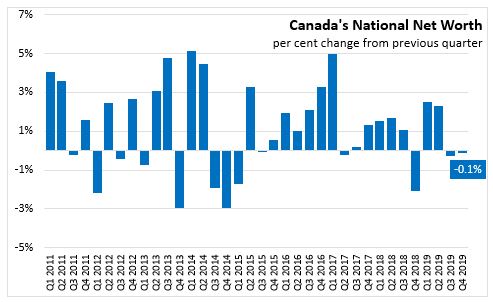
In the fourth quarter of 2019, Canadian national wealth declined 0.1 per cent (or $14.4 billion) to $11,719.2 billion. This follows a revised decrease of 0.3 per cent in the third quarter of 2019. As with the previous quarter, the negative growth was largely attributable to a decrease in the value of natural resource assets. Real estate asset values increased by 1.1 per cent and net foreign assets increased as there was stronger foreign stock markets compared to the Canadian Stock market.
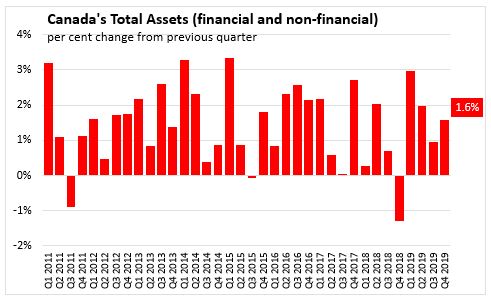
Total assets, including financial and non-financial assets increased by 1.6 per cent to $45,678 billion at the end of Q4 2019.
Household sector
In Q4 2019, Canada’s household sector net worth rose by 186.5 billion to $11,697.3 billion. Financial assets rose $153.8 billion, as it benefitted from revaluations in equity and investment fund shares. In 2019, residental real estate increased 3.3 per cent comapred to 2018 due to a moderate rebound in house prices.
Household borrowing decreased to $26.2 billion in Q4 2019. Consumer credit and non-mortgage lending declined to $7.8 billion in total while mortgage lending increased to $18.4 billion. In 2019, household borrowing increased to $95.1 billion comapred to $85.3 billion in 2018, it is still below preceding three years.
Household credit market debt as a proportion of household disposable income declined slightly to 176.3 per cent in Q4 2019.
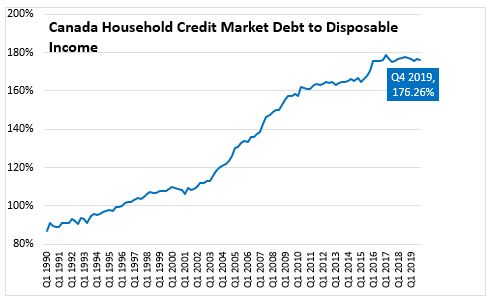
Household debt payments rose from 14.94 per cent to 14.98 per cent of disposable income (before interest payments), surpassing the previous high posted in the third quarter of 2019. However, there is a markedly different composition of debt service obligations for Canadian households as obligated principal payments have risen over the last 12 years while interest payments as a share of disposable income have fallen. Recent interest rate increases can explain most of the recent increase in Canada's debt service ratio.
In 2019 total debt payments increased 6.9 per cent and household disposable income rose 4.9 percent as compared to 2018.
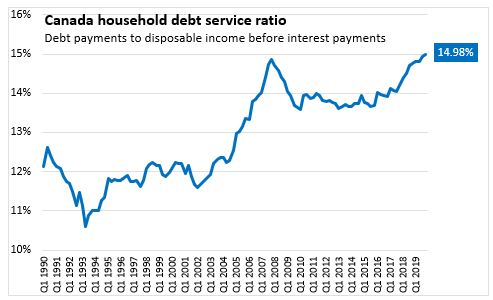
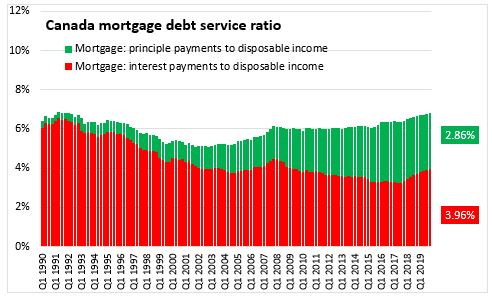
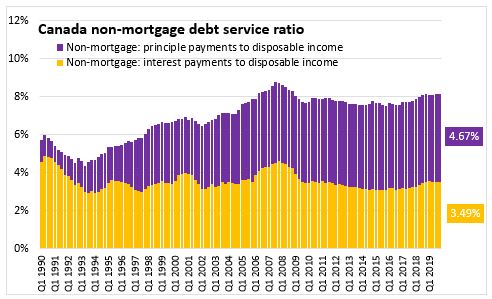
Government sector
At the end of Q4 2019, general government net debt (book value) declined to 39.86 per cent of GDP. The federal government's net debt to GDP ratio continues to fall, dropping to 26.17 per cent. Net debt of other levels of government is now larger than Federal government debt at 26.86 per cent of GDP.
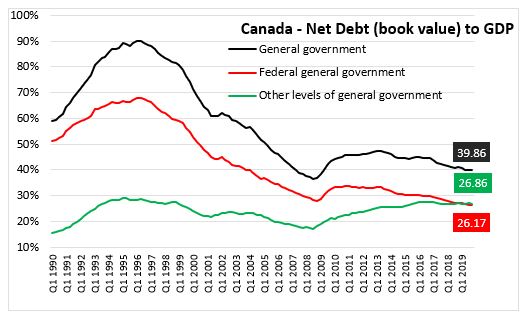
Corporate sector
The credit market debt to equity ratio of non-financial private corporations declined to 61.84 cents of credit market debt for every dollar of equity in the Q4 2019, down from 62.14 cents (revised) in Q3 2019.

Statistics Canada:
Table 11-10-0065-01 Debt service indicators of households, national balance sheet accounts
Table 36-10-0580-01 National Balance Sheet Accounts (x 1,000,000)
Table 38-10-0235-01 Financial indicators of households and non-profit institutions serving households, national balance sheet accounts
Table 38-10-0236-01 Financial indicators of corporate sector, national balance sheet accounts
Table 38-10-0237-01 Financial indicators of general government sector, national balance sheet accounts
Table 38-10-0238-01 Household sector credit market summary table, seasonally adjusted estimates
<--- Return to Archive